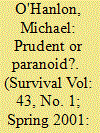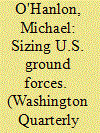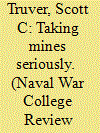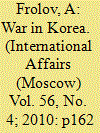| Srl | Item |
| 1 |
ID:
018744


|
|
|
|
|
| Publication |
2001.
|
| Description |
p37-52
|
|
|
|
|
|
|
|
|
|
|
|
|
|
|
|
| 2 |
ID:
133782


|
|
|
|
|
| Publication |
2014.
|
| Summary/Abstract |
During the Cold War, the United States varied between a "1 ½ war" and a "2 ½ war" framework for sizing its main combat forces. This framework prepared forces for one or two large wars, and then a smaller "half-war." Capacity for a major conflict in Europe, against the Soviet Union and its Warsaw Pact allies, represented the enduring big war potential. This period saw simultaneous conflict against China as a second possible big war, until Nixon's Guam doctrine placed a greater burden on regional allies rather than U.S. forces to address such a specter, and until his subsequent opening to the PRC made such a war seem less likely in any event. The half-wars were seen as relatively more modest but still quite significant operations such as in Korea or Vietnam.
|
|
|
|
|
|
|
|
|
|
|
|
|
|
|
|
| 3 |
ID:
133409


|
|
|
|
|
| Publication |
2012.
|
| Summary/Abstract |
A mine is a terrible thing that waits. The easy way is always mined. Any ship can be a minesweeper-once. Sea mines and the need to counter them have been constants for the U.S. Navy since the earliest days of the Republic. In January 1778, patriot David Bushnell used floating kegs of gunpowder fitted with contact firing mechanisms to attack a British fleet anchored in the Delaware River above Philadelphia. Four British sailors died trying to retrieve the kegs-an early example of the challenges of explosive ordnance disposal (EOD) against an unknown threat-but the ships were unscathed. Since that uncertain beginning, mines and mine countermeasures (MCM) have figured prominently in the Civil War, Spanish-American War, both world wars, Korea, Vietnam, numerous Cold War crises, and Operations DESERT STORM and IRAQI FREEDOM.
|
|
|
|
|
|
|
|
|
|
|
|
|
|
|
|
| 4 |
ID:
100181


|
|
|
|
|
| Publication |
2010.
|
| Summary/Abstract |
THE 1962 CUBAN CRISIS is most frequently cited as one of the most dangerous confrontations in world history. Even a greater threat for mankind was perhaps the Korean War of 1950-1953 that brought in its wake crushing losses for the people and economics of both North Korea and South Korea in terms of millions of human lives and destruction. The current tensions on the Korean peninsula have to do with the development of nuclear weapons by Pyongyang and, in a sense, with that war. Nuclear weapons proliferate where the threat to use them is very high. The USSR and the USA, which supported the warring sides, were causing an escalation of the conflict trying to outdo each other by supplying unheard of amounts of weaponry for that local war as they themselves were gradually and increasingly being drawn into combat operations. This is the only war in the USSR's history where its armed forces were fighting against the U.S. armed forces. The war came close to becoming global and to an exchange of nuclear strikes. This is why now, after 60 years on, the experience of the Korean War should serve as a stark reminder to those who are not averse to flex muscles.
|
|
|
|
|
|
|
|
|
|
|
|
|
|
|
|